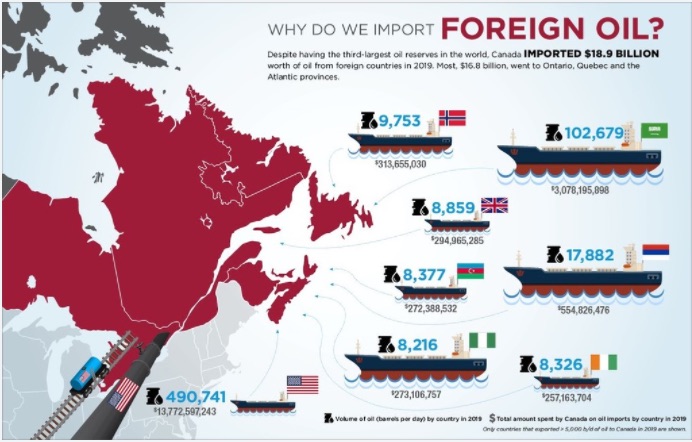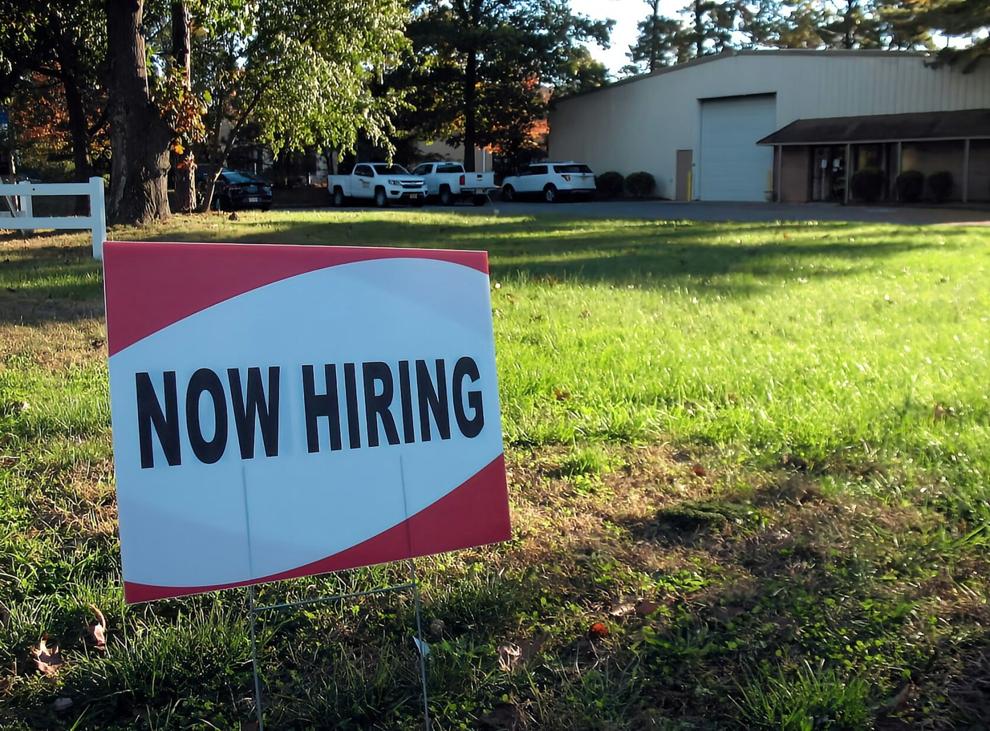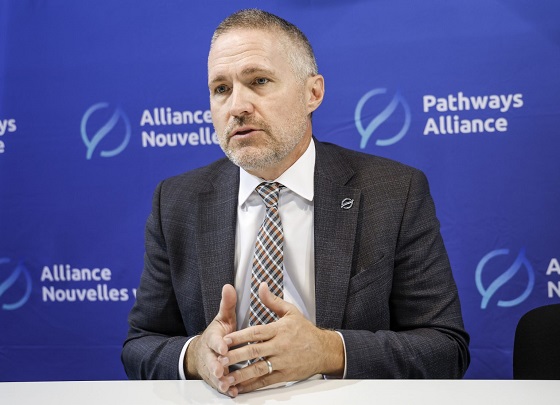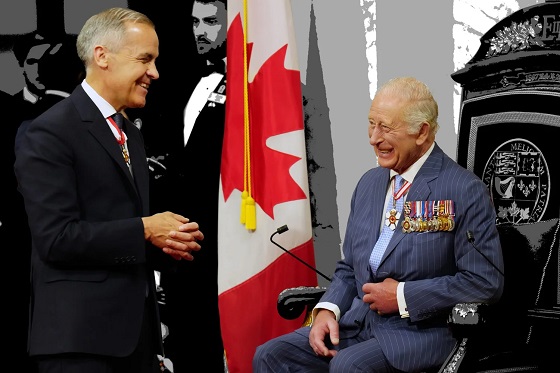Economy
Canada is not a serious country… Danielle Smith

From Danielle Smith
I read an infographic that said Canada has bought $13 billion worth of petroleum products from Russia since 2000 – we buy from them at a rate of $550 million a year. What the hell are we doing?
The situation for Ukraine looks very grave indeed. Most commentators thought Vladimir Putin was going to “liberate” the two Russia friendly break off republics of Donetsk and Luhansk. What a surprise to the world to find Russian soldiers in Kyiv among other incursions.
It is pretty clear the Russian leader intends to take all of Ukraine.
But we also must not be naïve about Putin’s aspirations. A Polish friend of mine – who remembers watching Russian tanks roll into her town outside her street when she was seven years old – is under no illusions about how far Putin intends to go.
She fully expects Belarus, Lithuania, Latvia, Estonia, Kazakhstan and possibly Moldova to be next. She believes Putin wants to assemble the Soviet Union 2.0, with the ultimate aim of controlling the energy supply to the rest of the world.
So how does this play out?
Just like you I’ve been trying to sort through the conflicting media coverage to find out what is really going on. If indeed there are Ukraine substates that genuinely want to be independent, I don’t have a particular problem with that. As I said in a Locals post, post WWII the powers that be made a lot of blunders redrawing the map of Europe and the Middle East, cramming people together under a national flag even if they hated each other, so perhaps some aspirations for independence are legitimate. But it’s clear that Putin’s aspiration goes far beyond Crimea, Donetsk and Luhansk. It appears now that he wants the whole thing. But why?
First off, though it’s sad to say, there hasn’t been much honest reporting about Ukraine and Russia starting in the Trump years so almost everything you read will be through the lens of people who hate Trump (who clearly understood Putin’s strength and saw no need to antagonize him) and Biden (whose family had strange dealings in Ukraine no one wants to talk about).
In addition there is so much propaganda floating around the web I’d be reluctant to retweet any stories of “bravery” unless they’ve been verified. Here’s a good summary of the lies so far: The Ghost of Kiev, the woman with the sunflower seeds, footage of things being shot down or blown up – so far most of these stories are outright falsehoods or images from video games or prior conflicts. The “Russian Warship Go Fuck Yourself” holdouts was partly true: yes they said it, but they didn’t die in a missile attack. They were all apprehended and taken alive.
So know that you have to read everything knowing that the writer is trying to manipulate you. I’m just trying to figure out what is actually going on. It’s not easy.
To that end…
The mainstream view as reported on BBC, is that Russia feels threatened by a modern Ukraine and irrationally believes it has been taken over by extremists and Nazis. I guess calling one’s political opponents “Nazis” is the new all-purpose smear being used by Russian Presidents and Canadian Prime Ministers alike to justify war measures. In any case, this analysis left me unsatisfied as it seemed a bit shallow and one-sided like so much of MSM these days.
Social media isn’t doing much better, and the commentariat seems to think this is the time to practice their best pop culture zingers. It’s kind of humiliating to read this piece that calls out the Harry Potter references, the self-care links and the demands to “deplatform” Russia: “If the West saw Ukraine and its cause as truly important, something worth paying a price to assist, they would sanction Russia’s energy sector. But they do not (even the Globalist American Empire must sometimes face reality). So instead, we get a parade of symbolic sanctions, passive-aggressive gestures of anger and hostility. In fact, the tactics the GAE uses against Russia — social ostracisim, deplatforming, and performative public condemnation — are the same feminine tools that it uses domestically to ruins the lives of people who use a politically incorrect word or donate to the wrong protest.” Ouch.
Here’s a video from a podcaster imbedded in Kyiv who says openly, “you’ll probably think I’m a Russian stooge” so he may indeed be a Russian stooge, but he explains why he thinks Russia (so far) has been restrained in its attack. He believes Ukrainians are fleeing because Ukraine President Volodymyr Zelensky is endangering them, by putting Kalashnikovs in the hands of untrained civilians who are going to be killed when confronted by professional Russian soldiers, and mandating military service for every man aged 18 to 60. He does not believe the Russians intend to cause mass casualties or destruction, but that they will kill if someone is pointing a gun at them, which will allow more reports depicting Putin’s viciousness.
He also explains how important Kyiv is to the Russian foundational story. As far as Putin is concerned, Ukraine is Russia, and he expected to be treated as a liberator when he arrived. He also outlined the different military tactics of Russia to explain why the West is saying that Russia is losing. When the US enters a country they do scorched earth and blow everything up – roads, bridges, electrical grids, water plants and so on. The fact that Putin is not doing that is being perceived as weakness. But if Putin wants Ukraine to be part of Russia permanently, it would make no sense to destroy everything. That doesn’t engender good feelings. Putin wants a puppet regime in Ukraine friendly to Russia’s interests – he doesn’t want to raze the joint or blow it smithereens.
Finally, this piece helped put a lot into perspective for me. “Ukraine’s Deadly Gamble” by Lee Smith has the ring of truth about it. He depicts it thus: “…(T)he Ukrainians made a geopolitical blunder that statesmen will study for years to come: A buffer state had staked its future on a distant power that had simply seen it as an instrument to annoy its powerful neighbor with no attachment to any larger strategic concept that it was willing to support.” They were a pawn in the game to help discredit Trump with the Russian collusion story, then when Trump started poking around to find out what the Bidens were up to in Ukraine, they played a willing role to aid his impeachment. Now they find out the Americans just aren’t that into them after all.
In the end, mid-size powers sleeping next to giants have to realize that their continued ability to remain independent is measured by whether they are perceived as antagonistic to the giant’s interests. If the situation was reversed – if Canada started cozying up to Russia and helping to sabotage US presidents to curry favour with Russia – I don’t think it would go well for us either. Maybe not full scale invasion, but the Americans hold life or death power over our economy so it wouldn’t be a wise move. Sad that regular citizens become the collateral damage in the decisions of their elected leaders. But that’s why elections matter.
If Canada was a serious grown-up country with a serious grown-up leader we’d be able to say “we can help” without being laughed off the world stage. We can help, in a very practical way. We can help wean the world off Russian oil and natural gas. We could ask Quebec to stop thinking only about itself for a change and reverse its announced ban on oil and natural gas extraction. Trudeau could declare multiple projects in the global interest and work with First Nations partners to complete Transmountain Pipeline and build Northern Gateway, work with Biden to build Keystone XL and with the provinces of QB and NB to build Energy East. He would use his powers under the Constitution to tell Quebec they can not block LNG Export from Saguenay, and he’d post a sentry of protectors for Coastal Gas Link to make sure it gets completed too.But look at this silliness: “despite the fact that 18 LNG export terminals have been proposed in Canada over the years, and 24 long-term LNG export licenses have been granted since 2011, a grand total of zero have been built.” We have failed the world with Trudeau’s anti-carbon-dioxide obsession. Let’s not forget it.
Canada is key to energy security and affordability for North America and our European allies, and we could hit Russia where it hurts. If we wanted to be a meaningful player on the international stage we would embrace it.
Instead we have a federal Environment Minister who made his name scaling the CN Tower and Ralph Klein’s house to oppose fossil fuels, and we’ve joined the Build Back Better brigade pretending the world can survive on wind turbines and solar panels alone.
Canada is not a serious place and our friends in Eastern Europe are now paying the price for it. Such a tragedy.
For more from Daniel Smith
|
|
|
|
|
|
|
Business
Socialism vs. Capitalism

People criticize capitalism. A recent Axios-Generation poll says, “College students prefer socialism to capitalism.”
Why?
Because they believe absurd myths. Like the claim that the Soviet Union “wasn’t real socialism.”
Socialism guru Noam Chomsky tells students that. He says the Soviet Union “was about as remote from socialism as you could imagine.”
Give me a break.
The Soviets made private business illegal.
If that’s not socialism, I’m not sure what is.
“Socialism means abolishing private property and … replacing it with some form of collective ownership,” explains economist Ben Powell. “The Soviet Union had an abundance of that.”
Socialism always fails. Look at Venezuela, the richest country in Latin America about 40 years ago. Now people there face food shortages, poverty, misery and election outcomes the regime ignores.
But Al Jazeera claims Venezuela’s failure has “little to do with socialism, and a lot to do with poor governance … economic policies have failed to adjust to reality.”
“That’s the nature of socialism!” exclaims Powell. “Economic policies fail to adjust to reality. Economic reality evolves every day. Millions of decentralized entrepreneurs and consumers make fine tuning adjustments.”
Political leaders can’t keep up with that.
Still, pundits and politicians tell people, socialism does work — in Scandinavia.
“Mad Money’s Jim Cramer calls Norway “as socialist as they come!”
This too is nonsense.
“Sweden isn’t socialist,” says Powell. “Volvo is a private company. Restaurants, hotels, they’re privately owned.”
Norway, Denmark and Sweden are all free market economies.
Denmark’s former prime minister was so annoyed with economically ignorant Americans like Bernie Sanders calling Scandanavia “socialist,” he came to America to tell Harvard students that his country “is far from a socialist planned economy. Denmark is a market economy.”
Powell says young people “hear the preaching of socialism, about equality, but they don’t look on what it actually delivers: poverty, starvation, early death.”
For thousands of years, the world had almost no wealth creation. Then, some countries tried capitalism. That changed everything.
“In the last 20 years, we’ve seen more humans escape extreme poverty than any other time in human history, and that’s because of markets,” says Powell.
Capitalism makes poor people richer.
Former Rep. Jamaal Bowman (D-N.Y.) calls capitalism “slavery by another name.”
Rep. Alexandria Ocasio-Cortez (D-N.Y.) claims, “No one ever makes a billion dollars. You take a billion dollars.”
That’s another myth.
People think there’s a fixed amount of money. So when someone gets rich, others lose.
But it’s not true. In a free market, the only way entrepreneurs can get rich is by creating new wealth.
Yes, Steve Jobs pocketed billions, but by creating Apple, he gave the rest of us even more. He invented technology that makes all of us better off.
“I hope that we get 100 new super billionaires,” says economist Dan Mitchell, “because that means 100 new people figured out ways to make the rest of our lives better off.”
Former Labor Secretary Robert Reich advocates the opposite: “Let’s abolish billionaires,” he says.
He misses the most important fact about capitalism: it’s voluntary.
“I’m not giving Jeff Bezos any money unless he’s selling me something that I value more than that money,” says Mitchell.
It’s why under capitalism, the poor and middle class get richer, too.
“The economic pie grows,” says Mitchell. “We are much richer than our grandparents.”
When the media say the “middle class is in decline,” they’re technically right, but they don’t understand why it’s shrinking.
“It’s shrinking because more and more people are moving into upper income quintiles,” says Mitchell. “The rich get richer in a capitalist society. But guess what? The rest of us get richer as well.”
I cover more myths about socialism and capitalism in my new video.
Business
Residents in economically free states reap the rewards

From the Fraser Institute
A report published by the Fraser Institute reaffirms just how much more economically free some states are compared with others. These are places where citizens are allowed to make more of their economic choices. Their taxes are lighter, and their regulatory burdens are easier. The benefits for workers, consumers and businesses have been clear for a long time.
There’s another group of states to watch: “movers” that have become much freer in recent decades. These are states that may not be the freest, but they have been cutting taxes and red tape enough to make a big difference.
How do they fare?
I recently explored this question using 22 years of data from the same Economic Freedom of North America index. The index uses 10 variables encompassing government spending, taxation and labour regulation to assess the degree of economic freedom in each of the 50 states.
Some states, such as New Hampshire, have long topped the list. It’s been in the top five for three decades. With little room to grow, the Granite State’s level of economic freedom hasn’t budged much lately. Others, such as Alaska, have significantly improved economic freedom over the last two decades. Because it started so low, it remains relatively unfree at 43rd out of 50.
Three states—North Carolina, North Dakota and Idaho—have managed to markedly increase and rank highly on economic freedom.
In 2000, North Carolina was the 19th most economically free state in the union. Though its labour market was relatively unhindered by the state’s government, its top marginal income tax rate was America’s ninth-highest, and it spent more money than most states.
From 2013 to 2022, North Carolina reduced its top marginal income tax rate from 7.75 per cent to 4.99 per cent, reduced government employment and allowed the minimum wage to fall relative to per-capita income. By 2022, it had the second-freest labour market in the country and was ninth in overall economic freedom.
North Dakota took a similar path, reducing its 5.54 per cent top income tax rate to 2.9 per cent, scaling back government employment, and lowering its minimum wage to better reflect local incomes. It went from the 27th most economically free state in the union in 2000 to the 10th freest by 2022.
Idaho saw the most significant improvement. The Gem State has steadily improved spending, taxing and labour market freedom, allowing it to rise from the 28th most economically free state in 2000 to the eighth freest in 2022.
We can contrast these three states with a group that has achieved equal and opposite distinction: California, Delaware, New Jersey and Maryland have managed to decrease economic freedom and end up among the least free overall.
What was the result?
The economies of the three liberating states have enjoyed almost twice as much economic growth. Controlling for inflation, North Carolina, North Dakota and Idaho grew an average of 41 per cent since 2010. The four repressors grew by just 24 per cent.
Among liberators, statewide personal income grew 47 per cent from 2010 to 2022. Among repressors, it grew just 26 per cent.
In fact, when it comes to income growth per person, increases in economic freedom seem to matter even more than a state’s overall, long-term level of freedom. Meanwhile, when it comes to population growth, placing highly over longer periods of time matters more.
The liberators are not unique. There’s now a large body of international evidence documenting the freedom-prosperity connection. At the state level, high and growing levels of economic freedom go hand-in-hand with higher levels of income, entrepreneurship, in-migration and income mobility. In economically free states, incomes tend to grow faster at the top and bottom of the income ladder.
These states suffer less poverty, homelessness and food insecurity and may even have marginally happier, more philanthropic and more tolerant populations.
In short, liberation works. Repression doesn’t.
-

 International1 day ago
International1 day agoOttawa is still dodging the China interference threat
-

 Business1 day ago
Business1 day agoThere’s No Bias at CBC News, You Say? Well, OK…
-

 Automotive1 day ago
Automotive1 day agoCanada’s EV gamble is starting to backfire
-

 International1 day ago
International1 day ago2025: The Year The Narrative Changed
-

 Business2 days ago
Business2 days agoResidents in economically free states reap the rewards
-

 Alberta2 days ago
Alberta2 days agoAlberta project would be “the biggest carbon capture and storage project in the world”
-

 Bruce Dowbiggin2 days ago
Bruce Dowbiggin2 days agoBe Careful What You Wish For In 2026: Mark Carney With A Majority
-

 Energy2 days ago
Energy2 days agoNew Poll Shows Ontarians See Oil & Gas as Key to Jobs, Economy, and Trade







